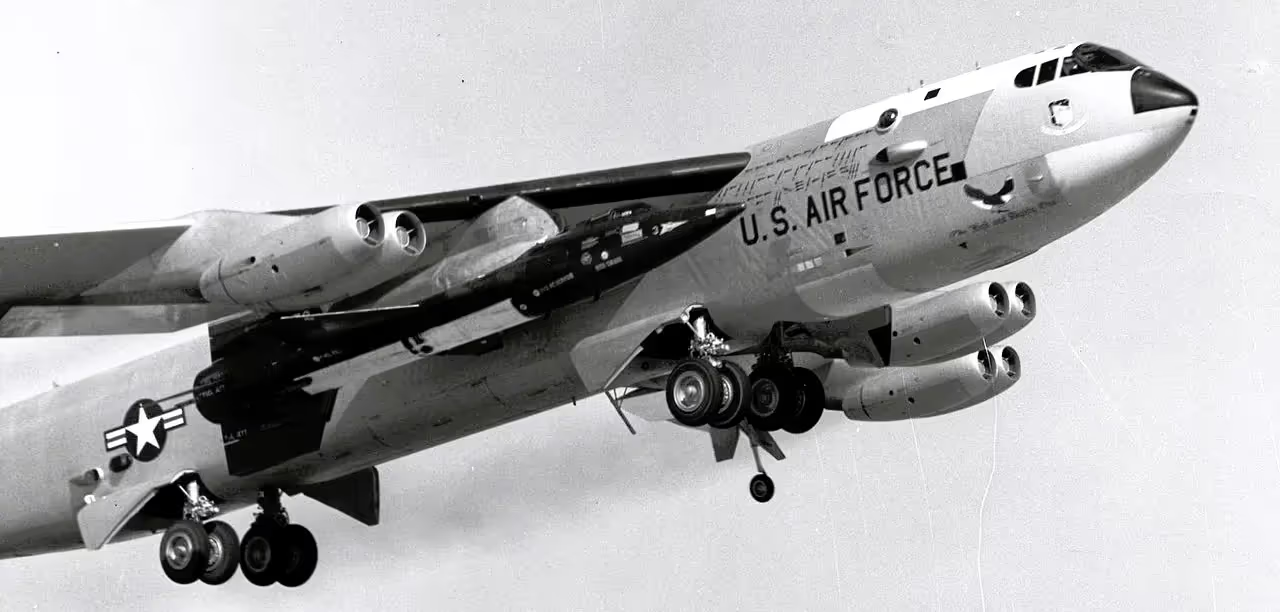Warplanes of the USA: North American X-15
North American X-15

(USAF Photo)
North American X-15 attached to its Boeing B-52 mother ship with a Northrop T-38 Talon flying nearby. Three X-15s were built, flying 199 test flights, the last on 24 October 1968.

(NASA Photo)
X-15A-2 (56-6671) with external fuel tanks, 1965.
The North American X-15 is a hypersonic rocket-powered aircraft operated by the United States Air Force and the National Aeronautics and Space Administration (NASA) as part of the X-plane series of experimental aircraft. The X-15 set speed and altitude records in the 1960s, crossing the edge of outer space and returning with valuable data used in aircraft and spacecraft design. The X-15's highest speed, 4,520 miles per hour (7,274 km/h; 2,021 m/s), was achieved on 3 October 1967, when William J. Knight flew at Mach 6.7 at an altitude of 102,100 feet (31,120 m), or 19.34 miles. This set the official world record for the highest speed ever recorded by a crewed, powered aircraft, which remains unbroken.
During the X-15 program, 12 pilots flew a combined 199 flights. Of these, 8 pilots flew a combined 13 flights which met the Air Force spaceflight criterion by exceeding the altitude of 50 miles (80 km), thus qualifying these pilots as being astronauts; of those 13 flights, two (flown by the same civilian pilot) met the FAI definition (100 kilometres (62 mi)) of outer space. The 5 Air Force pilots qualified for military astronaut wings immediately, while the 3 civilian pilots were eventually awarded NASA astronaut wings in 2005, 35 years after the last X-15 flight. (Wikipedia)

(USAF Photo)
North American X-15 pulling away from its mothership.
The X-15 was designed to be carried aloft and drop launched from under the wing of a B-52 mother ship. Air Force NB-52A, "The High and Mighty One" (Serial No. 52-0003), and NB-52B, "The Challenger" (Serial No. 52-0008), also known as Balls 8) served as carrier planes for all X-15 flights. Release of the X-15 from NB-52A took place at an altitude of about 8.5 miles (13.7 km) and a speed of about 500 miles per hour (805 km/h). The X-15 fuselage was long and cylindrical, with rear fairings that flattened its appearance, and thick, dorsal and ventral wedge-fin stabilizers. Parts of the fuselage (the outer skin) were heat-resistant nickel alloy (Inconel-X 750). The retractable landing gear comprised a nose-wheel carriage and two rear skids. The skids did not extend beyond the ventral fin, which required the pilot to jettison the lower fin just before landing. The lower fin was recovered by parachute.

(NASA Photo)
The X-15 #2 (Serial No. 56-6671) launches away from the B-52 mothership with its rocket engine ignited. The white patches near the middle of the ship are frost from the liquid oxygen used in the propulsion system, although very cold liquid nitrogen was also used to cool the payload bay, cockpit, windshields, and nose.

(USAF Photo)
Boeing NB-52A (Serial No. 52-003), permanent test variant, carrying an X-15, with mission markings; horizontal X-15 silhouettes denote glide flights, diagonal silhouettes denote powered flights.

(USAF Photo)
Boeing NB-52A launching an X-15.
Five principal aircraft were used during the X-15 program: three X-15 planes and two modified "nonstandard" NB-52 bombers:
X-15-1 – 56-6670, 81 free flights
X-15-2 (later X-15A-2) – 56-6671, 31 free flights as X-15-2, 22 free flights as X-15A-2; 53 in total
X-15-3 – 56-6672, 65 free flights, including the Flight 191 disaster
NB-52A – 52-003 nicknamed The High and Mighty One (retired in October 1969)
NB-52B – 52-008 nicknamed The Challenger, later Balls 8 (retired in November 2004)
Additionally, F-100, F-104 and F5D chase aircraft and C-130 and C-47 transports supported the program.

(USAF Photo)
X-15 just after release from the mothership.

(USAF Photo)
X-15 touching down on its skids, with the lower ventral fin jettisoned.
Both surviving X-15s are currently on display at museums in the United States. In addition, three mockups and both B-52 Stratofortresses used as motherships are on display as well.

(D Ramey Logan Photo)
X-15-1 (AF Serial No. 56-6670) is on display in the National Air and Space Museum "Milestones of Flight" gallery, Washington, D.C., but is currently undergoing conservation work at the Mary Baker Engen Restoration Hangar in the Steven F. Udvar-Hazy Center.

(NASA Photo)
X-15 #1 (Serial No. 56-6670), sits on the lakebed early in its illustrious career of high speed flight research. X-15-1, serial number 56-6670, is now located at the National Air and Space museum, Washington DC.

(USAF Photo)
.avif)
(USAF Photo)
.avif)
(ZLEA Photo)
.avif)
(Clemens Vasters Photo)
X-15A-2 (AF Ser. No. 56-6671) is at the National Museum of the United States Air Force, at Wright-Patterson Air Force Base, near Dayton, Ohio. It was retired to the museum in October 1969. The aircraft is displayed in the museum's Research and Development Gallery alongside other "X-planes", including the Bell X-1B and Douglas X-3 Stiletto.
Mockups
Dryden Flight Research Center, Edwards AFB, California, United States (painted with AF Ser. No. 56-6672).
Pima Air & Space Museum, adjacent to Davis-Monthan AFB, Tucson, Arizona (painted with AF Ser. No. 56-6671).
.avif)
(Clemens Vasters Photo)
Evergreen Aviation & Space Museum, McMinnville, Oregon (painted with AF Ser. No. 56-6672). A full-scale wooden mockup of the X-15, it is displayed along with one of the rocket engines.
Stratofortress mother ships
NB-52A (AF Ser. No. 52-003) is displayed at the Pima Air & Space Museum adjacent to Davis–Monthan AFB in Tucson, Arizona. It launched the X-15-1 30 times, the X-15-2, 11 times, and the X-15-3 31 times (as well as the M2-F2 four times, the HL-10 11 times and the X-24A twice).
NB-52B (AF Ser. No. 52-008) is on permanent display outside the north gate of Edwards AFB, California. It launched the majority of X-15 flights.

(NASA Photo)
Research aircraft at NASA's Ames/Dryden Flight Research Facility in 1993 (redesignated the Dryden Flight Research Center in 1994). Left to right: mock-up of North American X-15, F-18B, SR-71A, Rockwell-MBB X-31, and Grumman X-29.





